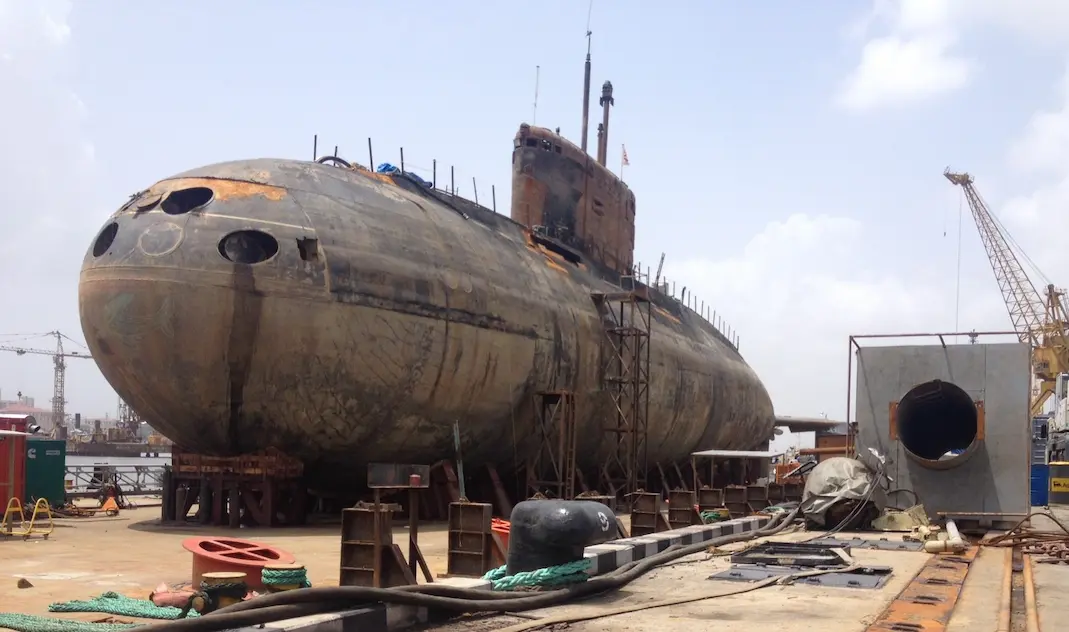
INS Sindhurakshak, a Kilo-class submarine, met a tragic fate in 2013 due to onboard explosions, leading to the loss of 18 crew members
INS Sindhurakshak was a Kilo-class submarine of the Indian Navy, commissioned in 1997 and built in Russia. It was one of India’s most advanced submarines, equipped with missiles, torpedoes, and modern navigation systems. However, on August 14, 2013, a massive explosion occurred in its weapons compartment, leading to its sinking at Mumbai’s naval dockyard. Tragically, 18 crew members lost their lives, making it one of the worst disasters in Indian naval history.
This blog delves into the history, accident details, investigation findings, and the impact of INS Sindhurakshak’s loss on India’s naval strategy.
History & Operational Significance
Commissioning & Deployment
INS Sindhurakshak was commissioned on December 24, 1997, as part of India’s Sindhughosh-class submarines. Built at Admiralty Shipyard in Saint Petersburg, Russia, it was designed for stealth operations, anti-ship warfare, and reconnaissance missions.
Role in the Kargil War (1999)
During the Kargil War, INS Sindhurakshak was deployed near Karachi, Pakistan, playing a crucial role in India’s naval strategy. Its presence ensured maritime security and deterrence against potential threats.
President Kalam’s Visit (2006)
In 2006, former President APJ Abdul Kalam became the first Indian head of state to sail in a submarine when he boarded INS Sindhurakshak. This event highlighted the importance of submarines in India’s defense strategy.
The Tragic Explosion & Sinking (2013)
What Happened?
On August 14, 2013, INS Sindhurakshak was docked at Mumbai’s naval base, preparing for a long deployment patrol. Late at night, a series of explosions rocked the submarine, causing it to sink.
Possible Causes of the Disaster – Investigations suggested that the explosion was likely caused by mishandling of ammunition, leading to a sympathetic detonation of missiles and torpedoes. Some theories also pointed to hydrogen gas leakage from the submarine’s batteries, but this was later ruled out.
Casualties & Rescue Efforts – The explosion resulted in the tragic loss of 18 crew members, including three officers and three underwater weapons specialists. Despite rescue efforts, no survivors were found.
Investigation Findings & Official Reports
Indian Navy’s Assessment
The Indian Navy ruled out sabotage, stating that the accident was likely due to mishandling of ammunition. The submarine was fully loaded with missiles and torpedoes, increasing the risk of a sympathetic detonation.
Expert Analysis – Naval experts suggested that the torpedo air flask, containing compressed oxygen, might have exploded due to a malfunction. This triggered a chain reaction, leading to the destruction of the submarine.
Final Fate of INS Sindhurakshak – After the tragic accident, INS Sindhurakshak was decommissioned in 2017 and later sunk in deep waters in the Arabian Sea.
Impact on India’s Naval Strategy
Strengthening Submarine Safety Protocols – Following the disaster, the Indian Navy enhanced safety protocols for handling ammunition and onboard equipment.
Modernization of Submarine Fleet – India accelerated its submarine modernization program, focusing on advanced safety features and improved training for naval personnel.
Lessons Learned – The loss of INS Sindhurakshak underscored the importance of rigorous safety checks, leading to better operational procedures for India’s submarine fleet.
Conclusion
INS Sindhurakshak’s tragic sinking remains one of the worst disasters in Indian naval history. While the exact cause remains debated, the incident led to major reforms in submarine safety and operational protocols.
As India continues to modernize its naval fleet, the lessons learned from INS Sindhurakshak’s loss serve as a reminder of the risks involved in underwater warfare.
Read – SpaceX Starship Flight 9 Set for May 28